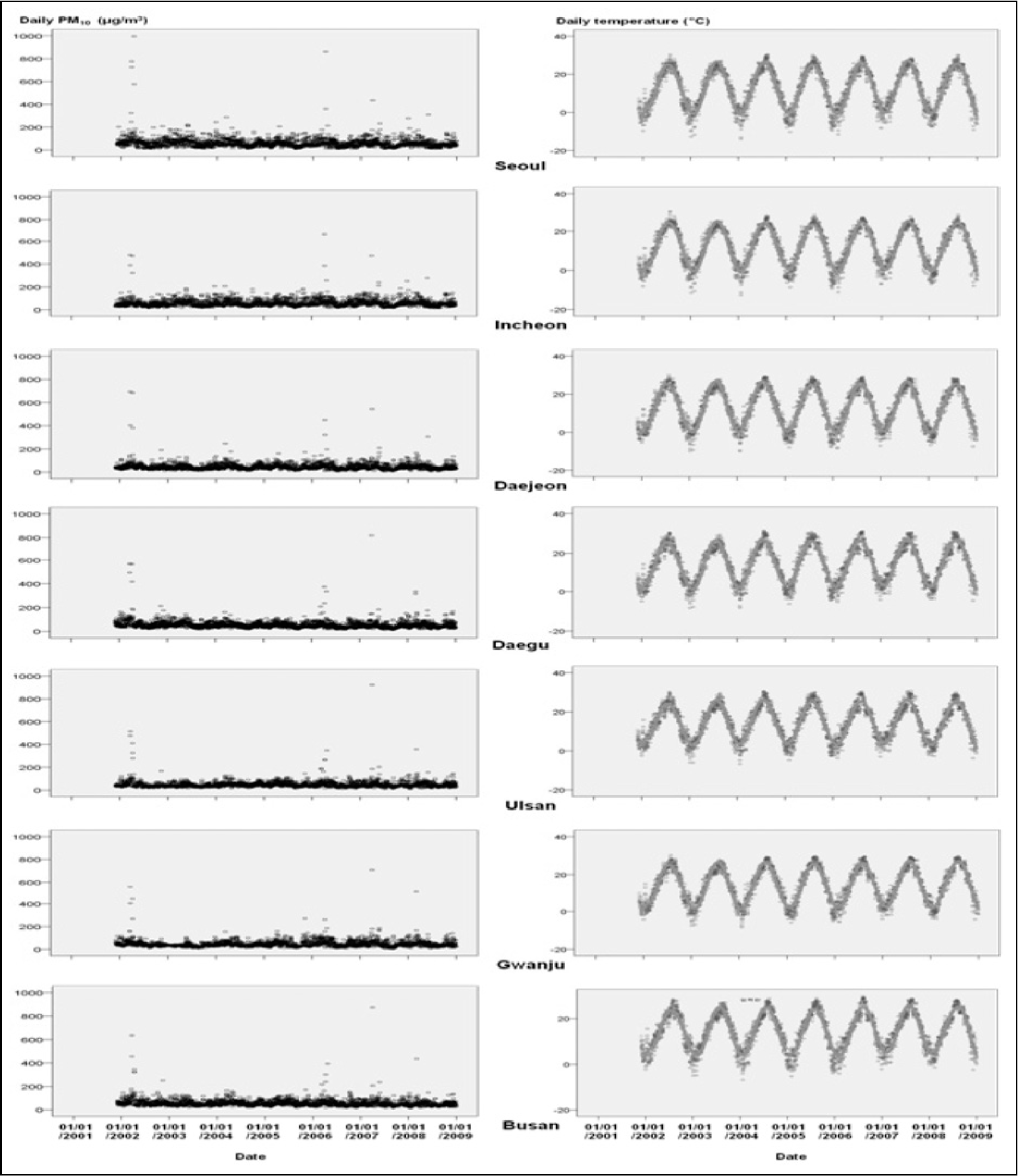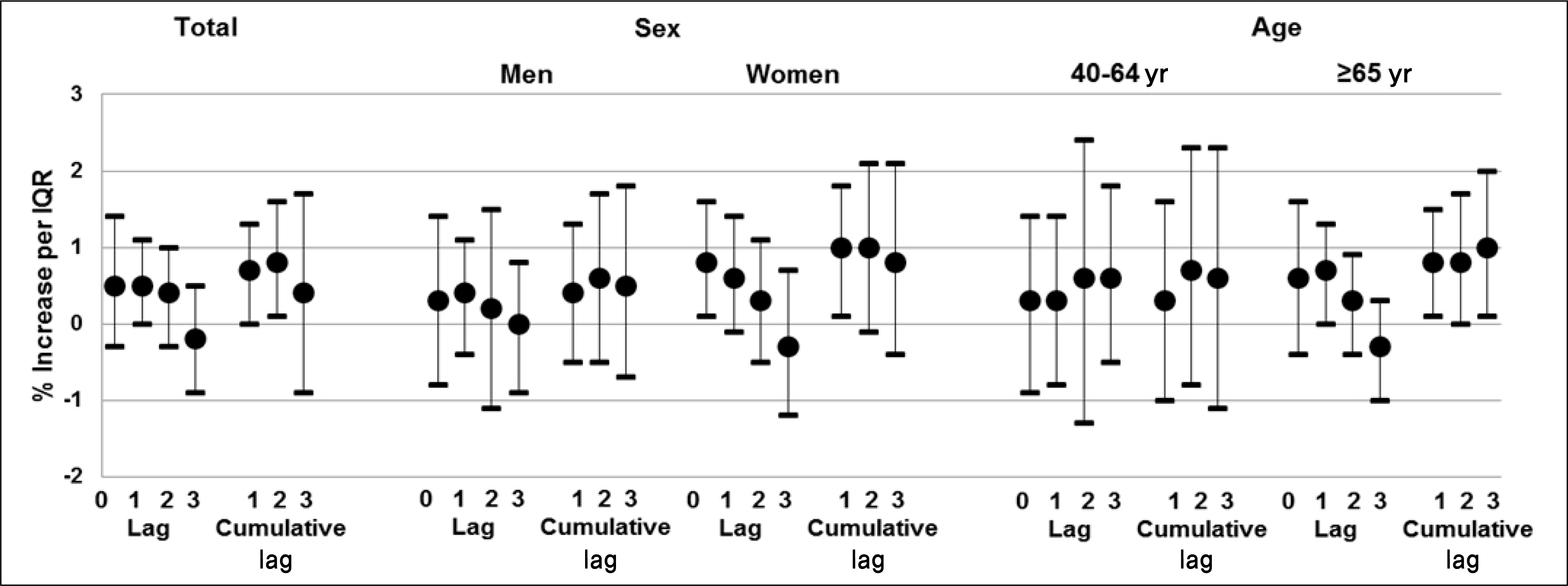ABSTRACT
Background:
To assess the association between ambient particulate matter and cardiovascular death in seven cities in the Republic of Korea during the period of 2002-2008.
Methods:
A time-stratified case-crossover design was used to examine association between particulate matter and deaths from cardiovascular or cerebrovascular disease; hypertensive disease 12,821, ischemic heart disease 39,577, cardiac arrhythmia 1,627, cerebrovascular disease 88,047. Mortality data was obtained from National Statistical Office, and hourly mean concentrations of particulate matter ≤ 10 µm in aerodynamic diameter and meteorological data were obtained from the Ministry of Environment. The percent increase in the risk of death associated with an interquartile range increase in particulate matter was determined by conditional logistic regression analysis after adjusting for national holidays and meteorological factors.
Results:
The largest association was a 0.8% increase (95% confidence interval [CI], 0.1–1.6) in death risk related to an interquartile range increase in particulate matter ≤ 10 µm (average of 0 to 2 days prior to the day of death). Classified as the cause of death, the association was a 1.2% increase (95% CI, 0.2–2.2) in death from cerebrovascular disease related to an interquartile range increase in particulate matter ≤ 10 µm. But others were statistically not significant. After stratification of death cases by year of death, statistically significant associations were a 2.3% increase (95% CI, 0.1–4.4) in death risk from ischemic heart disease in 2002–2004 and 2.0% increase in death from cerebrovascular disease (95% CI, 0.3–3.8) in 2006–2008.
References
1. Dockery DW, Pope CA 3rd, Xu X, Spengler JD, Ware JH, Fay ME, et al. An association between air pollution and mortality in six U. S. cities. N Engl J Med. 1993; 329:1753–9.
2. Laden F, Schwartz J, Speizer FE, Dockery DW. Reduction in fine particulate air pollution and mortality: Extended follow-up of the Harvard Six Cities study. Am J Respir Crit Care Med. 2006; 173:667–72.
3. Kaplan GG, Hubbard J, Korzenik J, Sands BE, Panaccione R, Ghosh S, et al. The inflammatory bowel diseases and ambient air pollution: a novel association. Am J Gastroenterol. 2010; 105:2412–9.

4. Kim C, Jung SH, Kang DR, Kim HC, Moon KT, Hur NW, et al. Ambient particulate matter as a risk factor for suicide. Am J Psychiatry. 2010; 167:1100–7.

5. Mar TF, Norris GA, Koenig JQ, Larson TV. Associations between air pollution and mortality in Phoenix 1995-1997. Environ Health Perspect. 2000; 108:347–53.

6. Pope CA 3rd, Burnett RT, Thurston GD, Thun MJ, Calle EE, Krewski D, et al. Cardiovascular mortality and long-term exposure to particulate air pollution: epidemiological evidence of general pathophysiological pathways of disease. Circulation. 2004; 109:71–7.
7. Neas LM, Schwartz J, Dockery D. A case-crossover analysis of air pollution and mortality in Philadelphia. Environ Health Perspect. 1999; 107:629–31.

8. Brook RD, Rajagopalan S, Pope CA 3rd, Brook JR, Bhatnagar A, Diez-Roux AV, et al. Particulate matter air pollution and cardiovascular disease: An update to the scientific statement from the American Heart Association. Circulation. 2010; 121:2331–78.
9. Miller KA, Siscovick DS, Sheppard L, Shepherd K, Sullivan JH, Anderson GL, et al. Long-term exposure to air pollution and incidence of cardiovascular events in women. N Engl J Med. 2007; 356:447–58.

10. Pope CA 3rd, Muhlestein JB, May HT, Renlund DG, Anderson JL, Horne BD. Ischemic heart disease events triggered by short-term exposure to fine particulate air pollution. Circulation. 2006; 114:2443–8.

11. Puett RC, Hart JE, Yanosky JD, Paciorek C, Schwartz J, Suh H, et al. Chronic fine and coarse particulate exposure, mortality, and coronary heart disease in the Nurses’ Health Study. Environ Health Perspect. 2009; 117:1697–701.

12. Sun Q, Hong X, Wold LE. Cardiovascular effects of ambient particulate air pollution exposure. Circulation. 2010; 121:2755–65.

13. Hong YC, Lee JT, Kim H, Ha EH, Schwartz J, Christiani DC. Effects of air pollutants on acute stroke mortality. Environ Health Perspect. 2002; 110:187–91.

14. Kwon HJ, Cho SH, Nyberg F, Pershagen G. Effects of ambient air pollution on daily mortality in a cohort of patients with congestive heart failure. Epidemiology. 2001; 12:413–9.

15. Hong YC, Lee JT, Kim H, Kwon HJ. Air pollution: a new risk factor in ischemic stroke mortality. Stroke. 2002; 33:2165–9.
16. Dominici F, Peng RD, Bell ML, Pham L, McDermott A, Zeger SL, et al. Fine particulate air pollution and hospital admission for cardiovascular and respiratory diseases. JAMA. 2006; 295:1127–34.

17. Maclure M. The case-crossover design: a method for studying transient effects on the risk of acute events. Am J Epidemiol. 1991; 133:144–53.

18. Navidi W. Bidirectional case-crossover designs for exposures with time trends. Biometrics. 1998; 54:596–605.

19. Katsouyanni K, Touloumi G, Spix C, Schwartz J, Balducci F, Medina S, et al. Short-term effects of ambient sulphur dioxide and particulate matter on mortality in 12 European cities: results from time series data from the APHEA project. Air Pollution and Health: a European Approach. BMJ. 1997; 314:1658–63.
20. Kelsall JE, Samet JM, Zeger SL, Xu J. Air pollution and mortality in Philadelphia 1974-1988. Am J Epidemiol. 1997; 146:750–62.

21. Schwartz J. What are people dying of on high air pollution days? Environ Res. 1994; 64:26–35.
22. Almon S. The distributed lag between capital appropriations and expenditures. Econometrica. 1965; 33:178–96.

23. Wellenius GA, Schwartz J, Mittleman MA. Air pollution and hospital admissions for ischemic and hemorrhagic stroke among medicare beneficiaries. Stroke. 2005; 36:2549–53.

24. Touloumi G, Samoli E, Quenel P, Paldy A, Anderson RH, Zmirou D, et al. Short-term effects of air pollution on total and cardiovascular mortality: the confounding effect of influenza epidemics. Epidemiology. 2005; 16:49–57.
25. Wong CM, Vichit-Vadakan N, Kan H, Qian Z. Public Health and Air Pollution in Asia (PAPA): a multicity study of short-term effects of air pollution on mortality. Environ Health Perspect. 2008; 116:1195–202.

26. Barnett AG, Williams GM, Schwartz J, Best TL, Neller AH, Petroeschevsky AL, et al. The effects of air pollution on hospitalizations for cardiovascular disease in elderly people in Australian and New Zealand cities. Environ Health Perspect. 2006; 114:1018–23.
27. Chen LH, Knutsen SF, Shavlik D, Beeson WL, Petersen F, Ghamsary M. et al. The association between fatal coronary heart disease and ambient particulate air pollution: Are females at greater risk? Environ Health Perspect. 2005; 113:1723–9.
28. McCracken J, Baccarelli A, Hoxha M, Dioni L, Melly S, Coull B, et al. Annual ambient black carbon associated with shorter telomeres in elderly men: Veterans Affairs Normative Aging Study. Environ Health Perspect. 2010; 118:1564–70.

29. Andersen ZJ, Olsen TS, Andersen KK, Loft S, Ketzel M, Raaschou-Nielsen O. Association between short-term exposure to ultrafine particles and hospital admissions for stroke in Copenhagen, Denmark. Eur Heart J. 2010; 31:2034–40.

30. Hoek G, Brunekreef B, Goldbohm S, Fischer P. van den Brandt PA. Association between mortality and indicators of traffic-related air pollution in the Netherlands: a cohort study. Lancet. 2002; 360:1203–9.
31. Maheswaran R, Haining RP, Brindley P, Law J, Pearson T, Fryers PR, et al. Outdoor air pollution and stroke in Sheffield, United Kingdom: a small-area level geographical study. Stroke. 2005; 36:239–43.
32. Piver WT, Ando M, Ye F, Portier CJ. Temperature and air pollution as risk factors for heat stroke in Tokyo July and August 1980-1995. Environ Health Perspect. 1999. 107:p. 911–6.

33. Tsai SS, Goggins WB, Chiu HF, Yang CY. Evidence for an association between air pollution and daily stroke admissions in Kaohsiung, Taiwan. Stroke. 2003; 34:2612–6.

34. Donaldson K, Tran CL. Inflammation caused by particles and fibers. Inhal Toxicol. 2002; 14:5–27.

35. O’Neill MS, Veves A, Sarnat JA, Zanobetti A, Gold DR, Economides PA, et al. Air pollution and inflammation in type 2 diabetes: a mechanism for susceptibility. Occup Environ Med. 2007; 64:373–9.
36. Ruckerl R, Greven S, Ljungman P, Aalto P, Antoniades C, Bellander T, et al. Air pollution and inflammation (interleukin-6, C-reactive protein, fibrinogen) in myocardial infarction survivors. Environ Health Perspect. 2007; 115:1072–80.
Fig. 1.
Daily average concentration of particulate matter (left) and air temperature (right) in seven cities, 2002-2008. The lines drawn are nonparametric smooths (natural cubic spline) of the data.

Fig. 2.
Random-effects estimates of change in deaths cardiovascular and cerebrovascular disease associated with an interquartile range increase in particulate matter. The day of death and 1, 2, and 3 days prior to the day of death from circulatory system disease were described as lag 0, lag 1, lag 2, and lag 3, respectively. Cumulative lag refers to cumulative lagged exposure, that is, the mean particulate matter concentrations on the specified day and all subsequent days. The interquartile range (IQR) was 39.05 µg/m3 for 10 µg particulate matter. Dots indicate the percent increase in death, and whiskers indicate 95% confidence intervals.

Table 1.
General characteristics of the study subjects in 2002-2008
| Deaths from cardiovascular and cerebrovascular disease | |||
|---|---|---|---|
| Period Ⅰ | Period Ⅱ | Total | |
| (2002-2004) | (2006-2008) | ||
| Characteristic | n=69,519 | n=68,341 | n=160,273 |
| Sex of death | |||
| Men | 33,703 (48.5) | 33,126 (48.5) | 77,710 (48.5) |
| Women | 35,816 (51.5) | 35,215 (51.5) | 82,563 (51.5) |
| Age at death | |||
| 40-64 yr | 17,649 (25.4) | 13,987 (20.5) | 36,894 (23.0) |
| ≥65 yr | 51,870 (74.6) | 54,354 (79.5) | 123,379 (77.0) |
| Region of death | |||
| Seoul | 27,757 (39.9) | 26,427 (38.7) | 63,199 (39.4) |
| Incheon | 8,241 (11.9) | 8,247 (12.1) | 19,045 (11.9) |
| Daejeon | 4,161 (6.0) | 3,984 (5.8) | 9,397 (5.9) |
| Daegu | 7,935 (11.4) | 8,022 (11.7) | 18,503 (11.5) |
| Ulsan | 2,745 (4.0) | 2,911 (4.3) | 6,607 (4.1) |
| Gwanju | 3,547 (5.1) | 3,732 (5.5) | 8,418 (5.3) |
| Busan | 15,133 (21.8) | 15,018 (22.0) | 35,104 (21.9) |
| Disease of death | |||
| Death from hypertensive disease | 5,251 (7.6) | 5,843 (8.6) | 12,821 (8.0) |
| Death from ischemic heart disease | 15,951 (22.9) | 17,955 (26.3) | 39,577 (24.7) |
| Death from cardiac arrhythmia | 476 (0.7) | 915 (1.3) | 1,627 (1.0) |
| Death from cerebrovascular disease | 40,748 (58.6) | 34,962 (51.2) | 88,047 (54.9) |
| Others* | 7,093 (10.2) | 8,666 (12.7) | 18,201 (11.4) |
Table 2.
Random-effects estimate of change in the risk of death associated with an interquartile range increase in particulate matter after stratification by subgroup (cumulative lag 1 and cumulative lag 2)
Table 3.
Random-effects estimate of change in the risk of death associated with an interquartile range increase in particulate matter after stratification by subgroup and year (cumulative lag 2)




 PDF
PDF ePub
ePub Citation
Citation Print
Print


 XML Download
XML Download